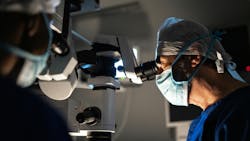Tooth-in-eye surgery performed successfully in Canada for the first time
Ian Tibbetts lived without his sight for 16 years due to a freak accident involving flying scrap metal in 1997. But in 2013, he was able to see his 4-year-old twins for the first time, thanks to a little-known operation that restored his sight with the use of his tooth called osteo-odonto-keratoprosthesis (OOKP).1
What is tooth-in-eye surgery?
OOKP, also known as "tooth-in-eye" surgery, is a medical procedure that can restore vision in the most severe cases of corneal and ocular surface patients. It includes removal of a tooth from the patient or a donor. After this, a lamina of tissue cut from the tooth is drilled and the hole is fitted with optics. The lamina is grown in the patient's cheek for a period of months and then is implanted upon the eye.1
Canada's first OOKP surgery
In Tibbetts's case, Dr. Christopher Liu at the Sussex Eye Hospital in Brighton, UK, inserted the lens into a hole drilled through the tooth, which was then implanted in Tibbetts's eye. Recently, however, Providence Health Care ophthalmologist Greg Moloney successfully performed this procedure on three patients in Canada, making their cases the first in the country.2
The procedure was performed on Canadian woman, Gail Lane, at Mount Saint Joseph Hospital.
"I haven't seen myself for 10 years," She said. "If I'm fortunate enough to get some sight back, there will be wonderful things to see."2
As for Tibbetts, he was also grateful to regain his vision, but it went beyond just that.
"I have my independence back now and I can start looking after the kids while my wife is out at work." He said. "Before, the kids were just shapes. I couldn't make them out. I had to actually learn to tell them apart by their voices ... I would do anything to get some sight back. I had to try something."1
How this procedure works
OOKP was pioneered by the Italian ophthalmic surgeon Professor Benedetto Strampelli in Rome in the early 1960s. By mostly relying on the body's own biological material, this procedure is intended to minimize the risk of a patient's body rejecting a foreign implant.
According to Dr. Liu: "Patients who have the surgery are often able to see immediately and the quality of sight can be extraordinarily good. However, it is only suitable for certain types of blindness, specifically patients who have severe and irreversible corneal damage."1
The risks involved in this procedure limit surgeons from performing it in only one of each patient's eyes. Even still, it has been performed in 10 countries with a relatively high success rate; a 2022 study from Italy determined roughly 94 percent of implant recipients could still see even 27 years after having the procedure. Not only that, but recipients from previous studies were reported to be able to drive cars after recovery.2
Photos from the surgery can be viewed here.
Response from Dr. Jason Auerbach, DDS
Dr. Auerbach, oral and maxillofacial surgeon and Dental Economics contributor known as @bloodytoothguy on Instagram, believes this type of surgery is both genius and extremely risky—one that should only be performed by a highly-skilled team under very specific circumstances. He has agreed to share his thoughts on OOKP following the success of the most recent procedure in Canada.
Do you think this procedure will ever become popular?
"I do not think this is mainstream and nor will it become mainstream. It’s reserved for extreme cases that are typically patients with severe corneal damage and no other options. That’s what makes it so special at the same time. It’s the kind of last-resort miracle that pushes the boundaries of medicine and shows what’s possible when surgical disciplines collaborate without ego or limitations."
With so many risks involved, is OOKP worth it?
"When done in the right hands and for the right patient, it’s definitely worth it. OOKP is reserved for where basically no other options exist. For patients who are otherwise permanently blind due to severe corneal disease or chemical burns, this is sometimes the only shot they’ve got at seeing again. That makes the risk not just acceptable. It makes it sometimes necessary."
Would you recommend it to the right patient?
"100%. If I had a patient whose ophthalmology team determined they were a viable candidate, psychologically prepared, medically stable, and committed to the process, I would absolutely advocate for it. The idea that we can take a tooth and restore vision with it? That’s the kind of cross-disciplinary brilliance and creativity that I love."
What does the future hold for OOKP, in your opinion?
"Do I think it’ll become more common? Probably not widely. It may evolve though. Because it’s so complex, and the indications are too rare, OOKP isn’t likely to replace LASIK or corneal transplants. But it’s a surgical option that can open doors. And as tech evolves, particularly in biomaterials and regenerative medicine, one could see some of its principles being adapted and scaled. The idea of using living tissue as a scaffold for long-term ocular implants is not so farfetched. Overall, it’s a testament to what can happen when we stop seeing disciplines in silos and start seeing the human body and surgical possibility, as one integrated creative system."
References
-
Man regains sight after doctors replace his eye with a tooth. GMA News Online. October 7, 2013. https://www.gmanetwork.com/news/scitech/science/329791/man-regains-sight-after-doctors-replace-his-eye-with-a-tooth/story/
-
Paul A. Surgeon implants teeth in patients' eye to restore vision. Popular Science. March 4, 2025. https://www.popsci.com/science/eye-in-tooth-surgery/
About the Author

Sarah Butkovic, MA, BA
Sarah Butkovic, MA, BA, is an Associate Editor at Endeavor Business Media, where she works on creating and editing engaging and informative content for today's leading online dentistry publications. She holds a Master's English Language and Literature from Loyola University Chicago and is passionate about producing high-quality content that educates, inspires, and connects with readers.

